Etruscan Hypogeum of San Manno,
Seen from the left burial chamber.

In their midst will be my dwelling place:
Ezekiel 37, 27
I will be their God
And they shall be my people
The monumental complex of San Manno,
in the western district of Horseshoe near the city of Perugia,
is now the operational center of the Magnificat Community.
Description
San Manno is a monumental complex whose origins date back more than two thousand three hundred years.
The oldest part consists of the Etruscan tomb. Consisting of a fairly large vaulted room made of travertine blocks, it can be dated to the 3rd century BC. On the left wall, upon entering, there is an inscription in Etruscan language, on three lines, among the longest of those that have come down to us.
Exactly above the Hypogeum, stand the 14th-century church and tower with what remains of 13th-century frescoes inside, as well as, above the altar, a 1585 fresco by Scilla Piccinini depicting the Eternal Father between St. Peter and Paul and the Virgin and Child. The rural house to the south is a former fortified monastery founded in 1512, which has been modified several times in subsequent eras.
Properties
The complex was originally owned by the Templars, then, in 1307 it was the residence of the Grand Master of the Jerusalemite Order of the Holy Sepulcher, and is currently owned by the Knights of Malta Order, who have granted its use on free loan to the Diocese of Perugia, which has entrusted it to the Magnificat Community.
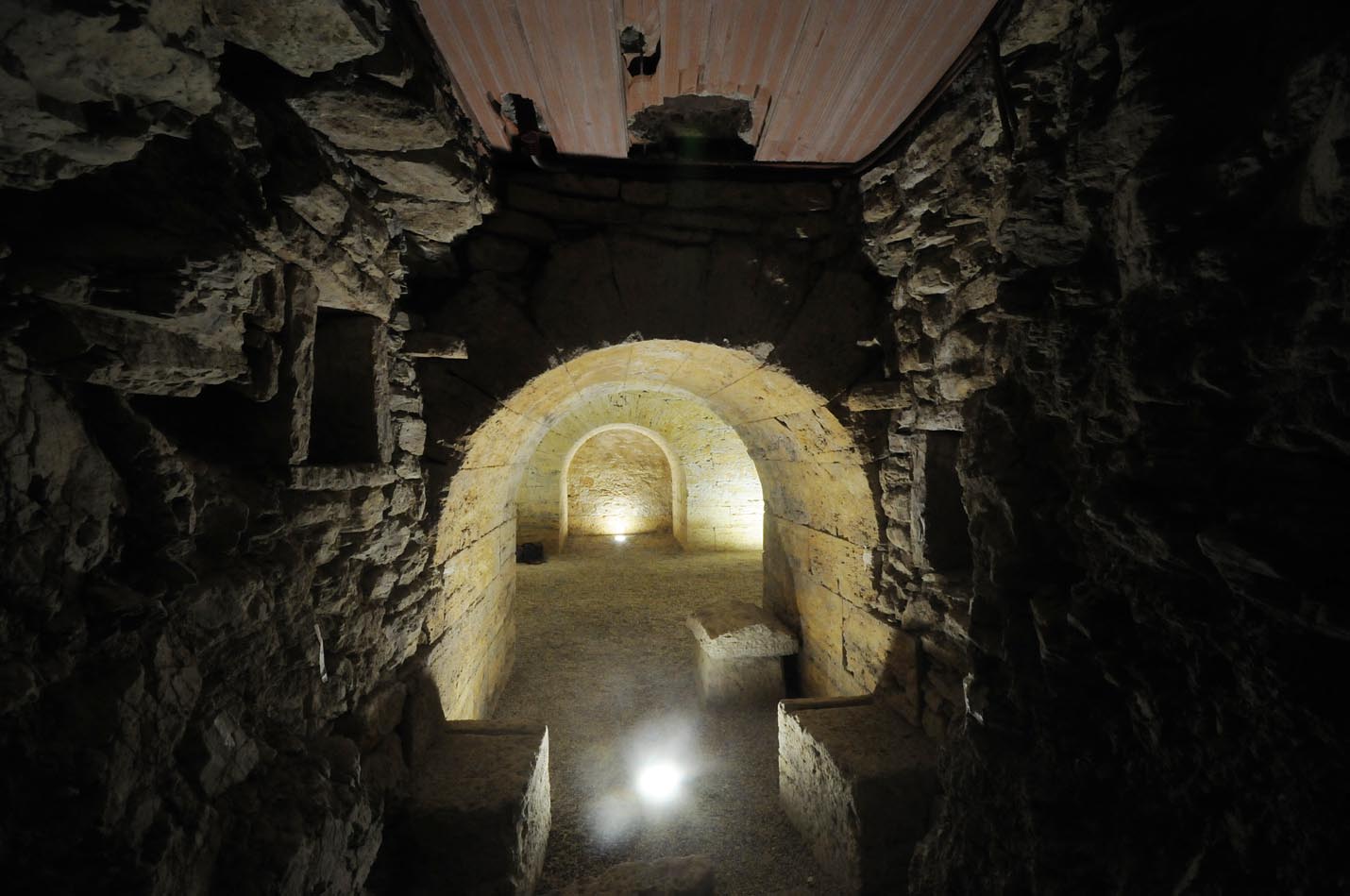
Etruscan Hypogeum of San Manno,
Seen from the left burial chamber.

In the foreground Wanda Rossi, behind her, with white hair, Ginette Girardet.
April 1979
During the Easter season Ginette Girardet is in France, in Lyon, to care for her sick mother, and during morning prayer she has the image of the St. Manno complex lit up by the sun and an inner voice tells her, “A charismatic community will live in this place and continuous adoration, contemplation, intercession for desperate cases will be made there.” On her return to Perugia she speaks about it with Agnese Mezzetti who listens and cherishes it in her heart, but thinks the undertaking is too big and does not talk about it with anyone.
August 1979
In August, Ginette is back in Lyon with her mother and sister. Back in Perugia, she telephoned Agnes for a greeting and asked that she be prayed over during the Small Community meeting that would be held a few days later. She feels weighed down and also wants to be reintegrated well into the Community after the two long absences (two months).
The following Friday, as usual, she arrived at the home of Agnese and her husband Marcello Bettelli, and-while dining with the family-she recounted from the beginning her own experience concerning San Manno: in 1973, having been widowed, she had come to live in Italy with her daughter Margherita, married to a Perugian man, who lived in Ferro di Cavallo. Passing by the San Manno complex she had had an inner locution, “You will live here.” Since this is repeated several times, she asks her daughter if she plans to rent or buy those houses. The daughter laughs because it would take too much money to make them habitable, and it all ends there. Then she tells about the image she had in prayer in Lyon, during Easter that year.
Marcello listens with interest, no one comments.
The brothers arrive for the prayer meeting, some are missing. When it is about to begin, they ring at the door: they are Stefano Ragnacci and Stefano Aquinardi who, from Papiano, have come to Perugia on an errand and before returning home decide to stop by and say hello to Marcello. Greeted with joy they are invited to stay and participate in prayer. Stefano Ragnacci says that this is not the case also because “he has short pants.” Reassured on this with a hint of humor, he is asked to impose his hands on Ginette since he had arrived as a “gift.” After a few moments of praise and invocation of the Holy Spirit, Stephen Ragnacci prophesies thus, “I see an old little church on a hill among the trees and an angel of the Lord who, pointing to it, says: you will dwell here with your community.” Then he continues, “I also see a comet star resting above the little church and leading a line of people who, as if in procession, are heading toward it. Inside is a nativity scene, but the Child is alive and gives off a great light. First, however, there will be something big that will make an obstacle, but in vain, the will of the Lord will triumph.”
Marco Benedetti opens the Bible and reads the passage from Isaiah: “The people who walked in darkness saw a great light; on those who dwelt in the land of darkness a light shone. You have multiplied joy, you have increased gladness. They rejoice before you as you rejoice when you reap and as you rejoice when you divide the prey. For the yoke that weighed on him and the bar on his shoulders, the rod of his tormentor you have broken as in the days of Midian. For every soldier’s shoe in the fray and every blood-stained cloak shall be burned, shall be bait of the fire. For a child has been born for us, a son has been given to us. On his shoulders is the sign of sovereignty, and he is called, Admirable Counselor, Mighty God, Father forever, Prince of Peace; great shall be his dominion, and peace shall have no end upon the throne of David and upon the kingdom, which he comes to consolidate and strengthen with right and justice, now and forever; this shall the zeal of the Lord of hosts do ” (9, 1-6).
Everyone senses the presence of the Lord speaking, and as soon as the prophecies are over, Marcello, in whose face there is great amazement, says, “The prayer is over, Ginette may I say what you told us earlier?” Joy fills hearts!
From that moment on, Marcello believes in God’s plan and works diligently on it. He begins the long journey, fraught with difficulties, to carry out the Lord’s will.
October 1979
At the Bettelli house we pray for a discernment requested by a sister named Clara (she is not from Perugia). Present are: Tarcisio, Agnese, Ginette, Clara, Lorenza and Stefano Ragnacci, who in the course of the prayer still prophesies, “I see a square tower, on top of which is a Great Host shining with light. The tower is surrounded by concentric circular walls.”
The tower of San Manno is square, but Stephen does not know this.

Eighteenth-century drawing
Of the San Manno complex.
March 1980
The name of the owners is known: The Sovereign Military Hospitaller Order of St. John of Jerusalem, of Rhodes and of Malta commonly called theOrder of the Knights of Malta (SMOM). The administrator for Umbria is Dr. Peppicelli who has an office in Horseshoe; he is difficult to meet. Meanwhile, an anonymous person donates one million liras for the reconstruction of San Manno.
May 1980
Marcello and Ginette are received by Dr. Peppicelli, who listens to the request, but is skeptical and evasive and warns that there is an ongoing negotiation with the City of Perugia for the purchase of the complex for the purpose of building a CVA there; asking price 120 million lire.
Disappointment, but no uncertainty about God’s will, and it is therefore decided to write a letter to the Grand Master of the Sovereign Military Order of Malta based in Rome. With great simplicity one introduces the Magnificat Community, an ecclesial reality that is part of the Renewal in the Spirit, to which the Lord, in prayer, inspired to establish in the houses of San Manno a place of spirituality centered on perpetual adoration of the Blessed Sacrament. They candidly declare that they have no money or other material goods, but that they firmly want to fulfill God’s plan.
Before sending the letter, Ginette, accompanied by Fr. Nazareno Bartocci and Bishop Lestini (diocesan vicar), is received by Archbishop Monsignor Ferdinando Lambruschini, from whom she asks for a signature of approval to the request. He immediately took pen and paper and wrote the following letter, a photocopy of which has been lost, but Ginette transcribed it in her diary: ” Most Eminent Highness, I accompany with full appreciation the humble supplication addressed to Your Alt. Em. concerning the little church with some premises in San Manno. The group that proposes to pursue these initiatives acts in total harmony with the Bishop, although I am unable to share all the optimism about the forecast. For many years I have been looking at St. Manno as a cultural center in an area in which popular buildings have multiplied. I believe that this group of willing and enthusiastic people can pave the way for the realization of this pastoral project. Therefore, the donation should be made to the diocese, in a manner to be agreed upon.
Iwill be infinitely grateful to V.A. if he will accept the plea seriously.I gladly avail myself of the opportunity to confirm with a sense of deep veneration and esteem.”
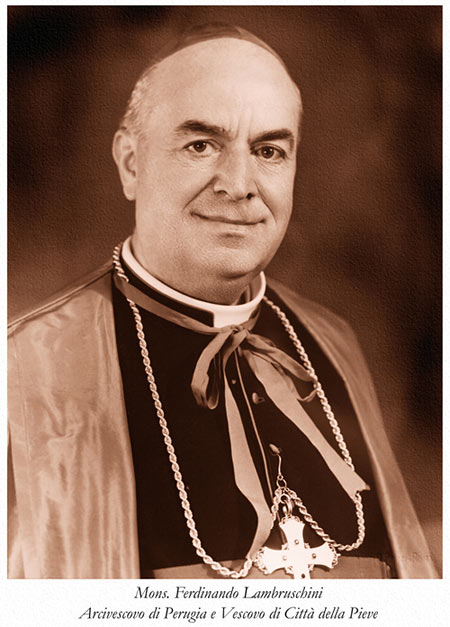
Monsignor Ferdinando Lambruschini (1911-1981), Archbishop of Perugia from 1968 until his death.
July 1980
It appears that the Knights of Malta has decided to follow up with the municipality; the news is reported in the municipal bulletin, and Dr. Peppicelli is no longer available.
An act of vandalism partially burns the chapel door. A novena is started in front of the
door.
On July 10, during the Small Community meeting at Bettelli House, Ermanno Colombo, who has never been interested in St. Manno’s, has a prophetic image: “Jesus in a flowering field of huge daisies that splits in two at waist height. The two parts become two mountains; from the mountain derived from the inner part of Jesus’ body flows a spring of copious waters in which there is a net full of people’s faces instead of fish. On the top of the mountain derived from the upper part of Jesus’ body is a tower. He wants to see what is inside, asks and enters it. First he sees angels and cherubim arranged in a triangle, then he sees a crowd kneeling and bowing forward in an attitude of worship. Finally he sees a cradle that seems to be filled with glowing molten metal and men with foundry spoons drawing from it.”
The image is interpreted by those present as follows: the flowery field is the Magnificat Community and Jesus is in the middle. The two mountains formed from the body of Jesus are symbolic of one of evangelization, the other of perpetual adoration united with the heavenly church, from which evangelization draws strength and effectiveness (the two charisms of the Community). This adoration purifies the Community “like gold in the crucible” to make it one bar of gold.
Lawyer Michele Cataldo acts as a go-between and makes an appointment for July 20 with Dr. Rossi, a Knight of Malta who lives near Magione.
Marcello, Agnes and Ginette go to him, who, upon receiving them, immediately makes it clear that the Order, due to the economic situation, needs money and is interested in the proposal of the municipality. He is very cold and discouraging.
Far from being discouraged, the three expound with disarming simplicity the prophecies they received in prayer and their firm intention to obey the Lord.
Immediate transformation of Dr. Rossi, who says, “Why didn’t you come earlier, when I had decision-making powers in the Order?” (for six months, in fact, he was no longer its secretary general). He adds that, in the past, he had his son draw up a plan to make there, a day hospital for the handicapped, but that it could not be realized. Finally, he recommends that the same people go to speak directly with the Prince Grand Master-Fra’ Angelo de Mojana-when, during the month of September, he would stay, as he did every year, in the castle of Magione.
That year, due to commitments that kept him abroad, the Grand Master Prince did not come.
The drafting of an initial plan for life at San Manno is made. Marcello and Ginette meet repeatedly with Dr. Peppicelli and the Bishop, who makes contact with the Grand Master Prince.
October 31, 1980
The Bishop telephoned the Bettelli home and invited them to go, at 2 p.m., to Hotel La Rosetta, for a meeting with Count Combi of Cesana, Grand Bailiff of the Order.
Marcello, Agnes and Ginette go on time and are greeted by the Count who had visited the Bishop in the morning. The project is presented as willed by God. The Count is moved and says, “Last night, going to bed, I was firmly resolved to give the complex to the municipality, but when I woke up this morning, I inexplicably changed my mind and decided to give it to the Bishop.” The Count’s face is streaked with tears and he recommends praying for the Order, which is in such need.
April-July 1981
Ginette receives the keys to San Manno from Dr. Peppicelli and together with Marcello, Fabio Palombaro and Michele Cataldo they visit the complex.
On April 17, 1981, the first Mass is celebrated at San Manno. The pastor of the Magnificat Community is present. Tarcisio Mezzetti becomes convinced that this is God’s plan.
On April 20, 1981, prayer began at St. Manno’s with the Rosary. It will be recited every Tuesday afternoon.
On May 30, 1981, the first adoration of the Blessed Sacrament brought by Agnes was held with the permission of the Bishop, who recommended that Consecrated Bread be consumed on the spot at the end of the prayer. This meeting will be held every Friday afternoon, while on Saturdays, after dinner, a charismatic prayer meeting is held from 9 to 11 p.m.
On June 15, 1981, the radio announces that there has been a fire at the small church of San Manno. The chapel door is completely consumed. An employee of the Knights of Malta speculates that it was done out of resentment against the Charismatics.
Prayer meetings now have to go through the inner courtyard because the Knights, the Monuments Superintendent, the Fire Department and the Police have barred the entrance to the little church with a fixed wooden wall. On June 18, 1981, while the candlelight prayer meeting is taking place, behind the wooden wall a group of young people are making loud noises. Nicoletta Tortoioli reads this prophecy: ” He said, “Give ear, all you people of Judah, inhabitants of Jerusalem, and you, King Jehoshaphat. The Lord says to you, Fear not and be not afraid before this vast multitude, for the war is not directed against you, but against God. Tomorrow, come down against them; behold, they will go up by the ascent of Ziz. You will surprise them at the end of the valley opposite the desert of Ieruel. It will not be your turn to fight at such a time; stop well ordered and see the salvation that the Lord will work for you, O Judah and Jerusalem. Do not fear and do not be downcast. Tomorrow, go out to meet them; the Lord will be with you.” Jehoshaphat knelt down with his face to the ground; all Judah and the inhabitants of Jerusalem prostrated themselves before the Lord to worship him “(2 Chronicles 20:15-18).
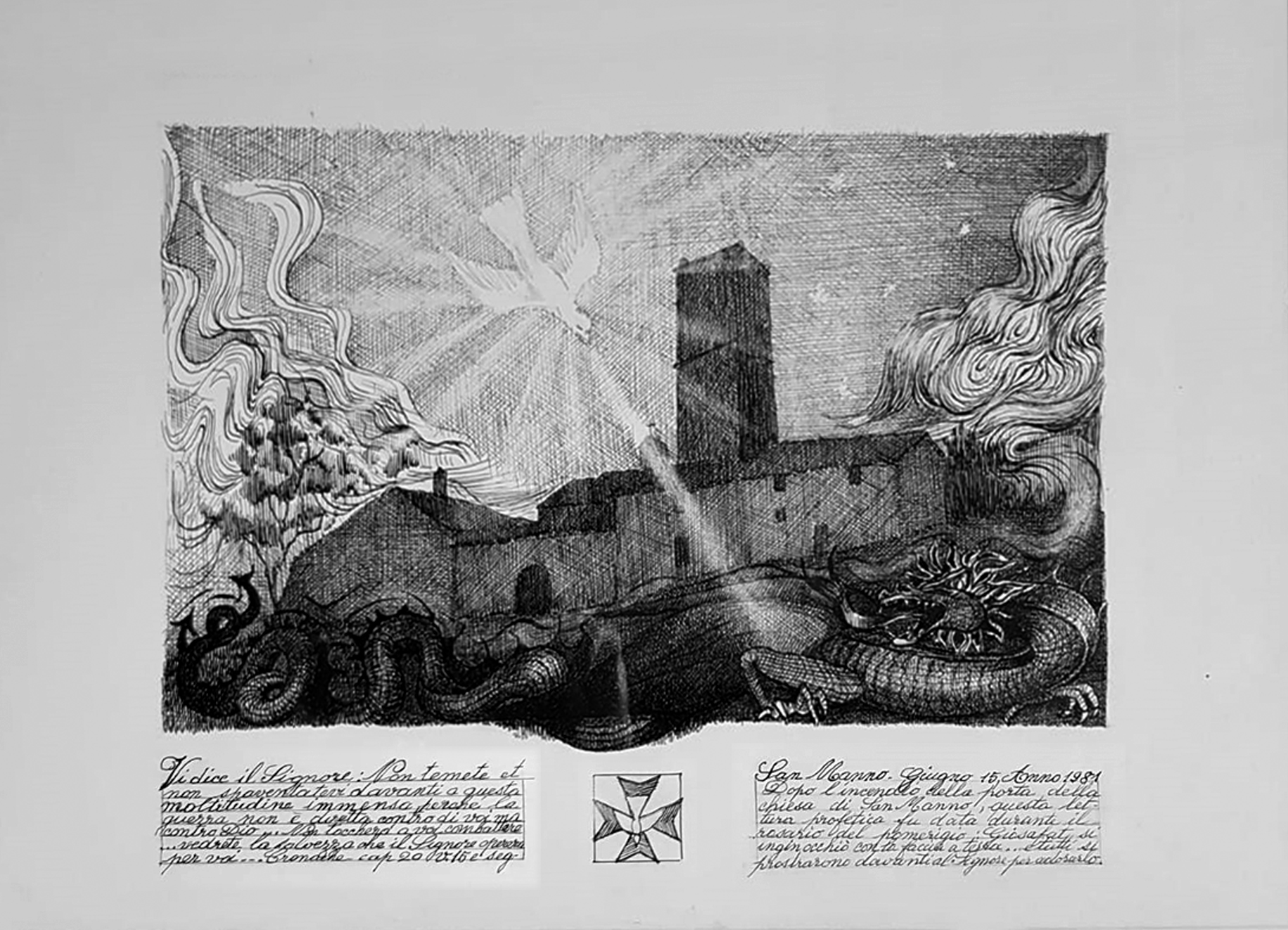
Ink drawing made by Ginette Girardet to commemorate the fact of the June 15, ’81 fire and the prophecy received three days later.
Eucharistic Adoration will now take place at the chapel of the sisters of San Donato all’Elce.
On July 12, 1981, during the Community Day at Mount Malbe Father Raniero Cantalamessa gave the meditation. It is his first meeting with the Magnificat Community. After the teaching, he is brought together with Ginette who acquaints him with the experience related to the life project at San Manno. Father Raniero shows interest and assumes its spiritual direction. Meetings between Father and the Community become frequent.
On July 20, 1981, the Archbishop, Monsignor Lambruschini, died suddenly and was succeeded by Monsignor Cesare Pagani, with whom everything had to start over.

Father Raniero Cantalamessa gives a teaching to the Community in the early 1980s.
1982
In January, Agnese went to the bishop to inform him about the San Manno project, but Monsignor Pagani proceeded with caution: he wanted to visit the place-which he would later describe as “evanescent”-before making contact with the Order of Malta, and there is a lot of work he has to take on in the two new dioceses; it must wait.
On March 10 Father Raniero delivers a copy of a prophecy he received on January 12, 1979. Surprising affinity with the San Manno project.
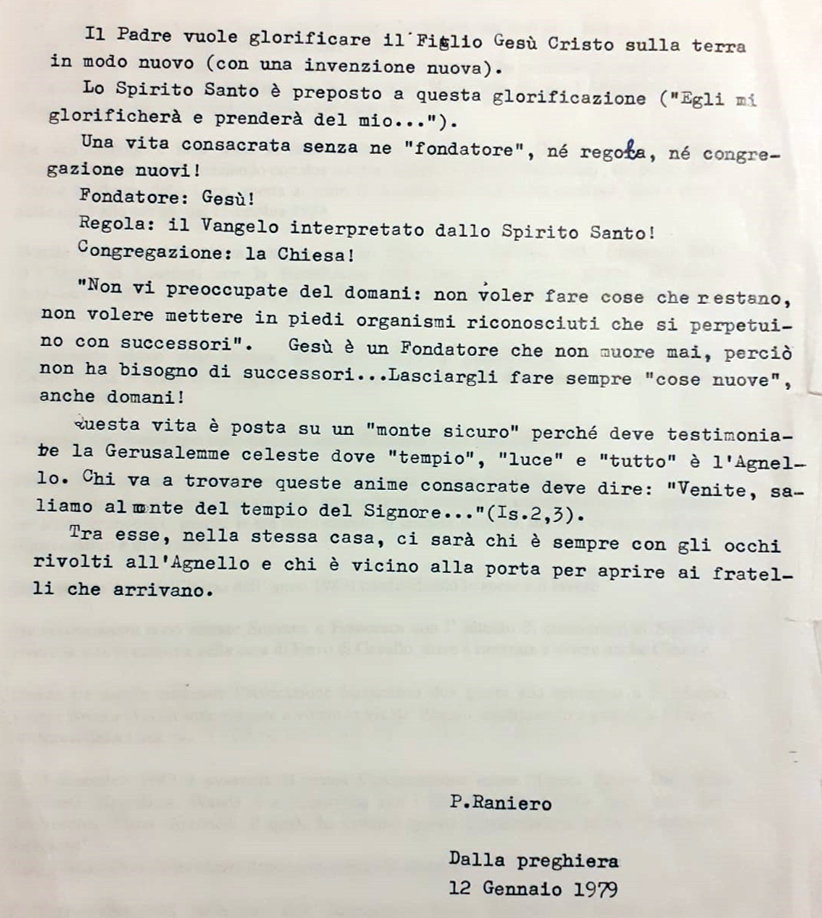
Text of a prophecy received from Father Raniero Cantalamessa.
On September 18, 1982, the Grand Master of the Order is in Magione and visits the Bishop. During the meeting he confirms the free offer of the complex to the Diocese, for the work that the Magnificat Community wants to carry out under the Bishop’s responsibility.
Meanwhile, a brother of the Community, architect Fabio Palombaro, drew up a project involving a cursory restoration whose expense would be around 200 million liras. But the Knights of Malta want a more thorough job and offer to contribute to the cost of some renovations.
A second project (500 million lira) is then prepared, which is deemed too expensive, then a third.
Meanwhile, the City of Perugia, which was thinking of taking possession of San Manno unleashes some gales. The alderman for public works has declared open war and says that to get San Manno one will have to go over his dead body. His active hostility will cease only when he is removed from office, when he moves from the City Council to the Province elected in the Administrations. Meanwhile, there is retaliation against the Bishop, who is threatened with forced expropriation.
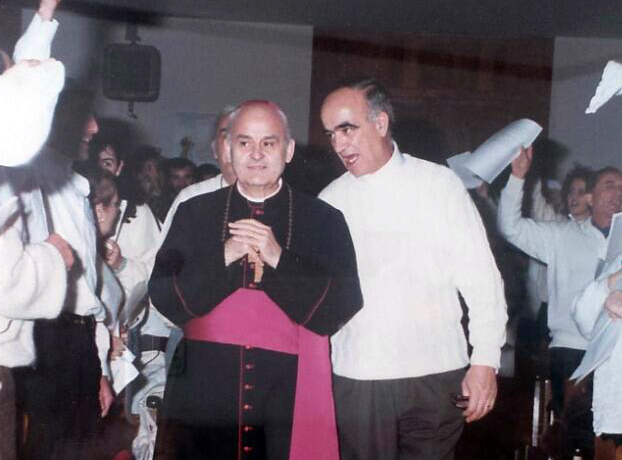
Monsignor Cesare Pagani (1921-1988), Archbishop of Perugia from 1981 until the day of his death, accompanied by Marcello Bettelli, on the community day on December 8, 1987, at the Franciscan Cenacle of Santa Maria degli Angeli (Perugia)
1983
Dec. 20, 1983. The struggle becomes intense. The Bishop, who is very concerned, summons the Community in the people who were in charge of the project and some of those in charge.
The Mayor let him know of his determination to take over San Manno to make a CVA there. The Bishop offers the Community more houses for the realization of his project. Astonishment seizes everyone; Ginette rushes up and kneels at the Bishop’s feet protesting that it was the Lord who pointed out that place for the adoration of the Blessed Sacrament. The Bishop is surprised and upset and even more so when Father Raniero, who is among those present, adds that that is the only place, in all of Christendom, that preserves the memory of this Camaldolese saint and, therefore, precious to the diocese of Perugia.
The bishop consents and dismisses.
Father Raniero, Marcello, Ginette travel to Rome to see Prince Grand Master Fra’ Angelo de Mojana of Cologna. A 10-minute meeting, but … to no avail.
On Dec. 28, 1983, the Community is convened and Tarcisio proposes a free self-taxation to be donated in one or two years to reach the necessary amount (300 million) to carry out the work. Who pledges for one million, than for two. The response is immediate and generous.
There had been complaints that instead of donation, SMOM had preferred Comodato. In the face of threats of expropriation by the municipality, this is considered providential because the Order cannot be expropriated as it enjoys International Law.
The battle escalates and finds its way into the pages of local newspapers.
The Knights of Malta seems to be about to give in to the City’s compromise: the colonial part for the CVA and the historic part to the Community.
Father Raniero writes a letter to the Bishop asking that he take a stand in favor of the Community project. He also intervenes with the Order. There will also be an appeal to the Regional Administrative Court of Umbria. Adv. Franchi, legal counsel for the Curia, takes on the defense for the Community. Within a little more than a month the case is argued and the Community comes out the loser. The lawyer expresses amazement, both at the short time and the outcome and says, “Just your prayers!”
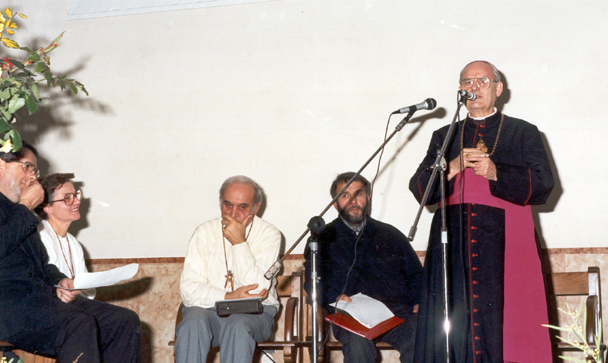
Monsignor Cesare Pagani, standing, speaks to the Community on Dec. 8, 1987.
Father Fernando Sulpizi, Agnese Mezzetti, Tarcisio Mezzetti, Fr. Giuseppe Gioia are recognized from left.
1984
In the first days of August, while the Community is experiencing summer camping in Palinuro, the local priest, Fr. Gerardo Bonora, proclaims a prophecy: “The Lord wants to dwell in the midst of these people of the Magnificat and asks that the ‘Tent of the Meeting’ be set up.” There is puzzlement because there is a lack of an available tent, but the priest insists: he is sure that this is what the Lord desires. Eucharistic adoration then begins with a poor arrangement in a car, where the Blessed Sacrament is adored all night by Wanda, extraordinary minister of Communion, by the dim light of a candle.
The next day a bus is arranged as a small chapel and worship continues with brothers taking turns in shifts.
The Lord is not slow to respond with healings and extraordinary events.
On September 10, the Lord urges for Adoration to begin. Agnes and Ginette go to the Bishop who approves the initiative and sends them to Don Ugo Coli to choose the church. Don Ugo receives them, listens with interest and immediately makes himself available. He is ready to give whichever one is preferred among St. Stephen’s, St. Teresa and St. Anne’s and Our Lady of Light. The latter little church, on which the choice falls, has been closed for a long time: it has broken rose window glass and a floor full of dirt. It is being cleaned up and conveniently arranged.
On Oct. 14, Father Raniero passed through Perugia and celebrated the first Mass at Our Lady of Light, consecrating the Magna Host that would later be displayed.
On October 15, during the Community Day at the Franciscan Cenacle in Assisi, Agnes informs the Community that perpetual Adoration will begin the following day and takes sign-ups for guard shifts. The response is generous: among them is Salvatore Caputo, who will be present every morning, except Sunday, and will help Agnes, who will have the honor of exposing and storing the Blessed Sacrament. On December 18 Father Raniero wrote a letter to Grand Master Fra’ Angelo de Mojana of Cologna urging the stipulation of the contract for the loan of San Manno to the Diocese, saying he was convinced that it was God’s plan. He writes: ” I intervene in the matter in a purely spiritual capacity. I have been following this project since its inception; I am convinced that it is God’s project, that is, that it is God (not some person, or group of people) who desires that place to be “restored” to his worship, reactivated for his glory and for the spiritual good of his people increasingly poisoned with materialism. “San Manno is the only existing place in the entire Catholic Church that preserves the historical memory of the Perugian saint of the same name who lived there as a hermit so many centuries ago. To want to erase that memory, by assigning the complex to civilian uses (for which there are many other possibilities), is to make oneself responsible for a spiritual and cultural damage, towards the city of Perugia itself, which is extremely serious, and which no amount of social or cultural service spic and span could compensate for. […] She knows that in Perugia there is a Christian community, the “Magnificat” community of the Renewal in the Spirit, which has been gathering that desire for God that I mentioned above, without any human interest of its own, but rather facing difficulties of all kinds and obnoxiousness from forces hostile to the faith; such people have been self-taxing to begin to put together the necessary funds for the restoration. But all of this is hanging in a vacuum until there is a contract that creates the legal basis for them to act…. “.
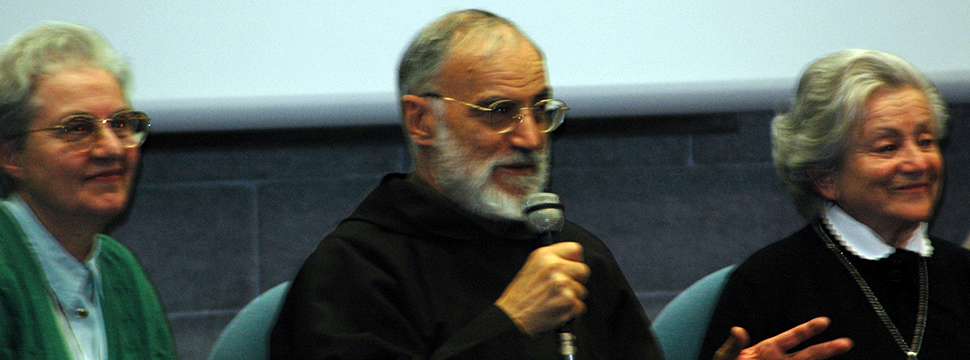
Father Raniero Cantalamessa speaks to the Community, December 8, 2004.
To his left is Agnese Mezzetti and to his right is Wanda Rossi.
1985
On Feb. 11, feast of Our Lady of Lourdes, Wanda and Ginette begin their life together. Bishop Pagani celebrates Holy Mass in the presence also of Don Alberto Veschini and Don Ugo Coli. At the end, they go up Via del Poggio and enter the apartment made available by Baroness Anna Monaco. The bishop blesses and, in joy and emotion, light refreshments are consumed. On July 2, the signing of the Contract of Commodity between SMOM and the Archiepiscopal Curia of Perugia-Città della Pieve takes place.
1986
On Sept. 10, the Contract of Commodity between the Curia and the Magnificat Community is signed.
On March 4, San Manno reopened with a Mass celebrated by Fr. Alberto and Eucharistic Adoration began again.
The name “Agnus Dei”: While various names were being proposed, which did not find full consensus, one day Agnes is in St. Manno’s chapel for something to do and as she pauses in front of the altar she is struck by the writing on the sash waving from the staff of St. John the Baptist: “Ecce Agnus Dei.” She is sure: Agnus Dei will have to be the name. She talks about it with those involved and everyone agrees, including Father Raniero.
1988
On March 12, Monsignor Cesare Pagani died, and was succeeded by Monsignor Ennio Antonelli, with whom talks were to begin again.
1991
On Sept. 27, Wanda buys-using all her possessions-and later gives to the Community Foundation, the apartment on Via Fra’ Giovanni da Pian di Carpine in Horseshoe, opposite San Manno. Salvatore adds a contribution for the purchase of the attic, asking for a commitment to take in his daughter Maria Pia, should she find herself in need.
Anna Brazzini, with all her savings, purchased the apartment on Via della Sposa in order to have, in the vicinity of Our Lady of Light, a home for those in charge of the Chapel.
1992
On March 27, the roof of the historic part of San Manno collapses.
1993
Between March and June, construction paperwork is forwarded to the City of Perugia to carry out restoration work on San Manno, by Community member engineer Luigi Fioroni.
On December 27, the municipality issues a building permit to carry out the work.
1994
In June, work began in San Manno, which was then suspended due to lack of funds.
1997
On Sept. 27, the earthquake that struck Umbria further damaged the San Manno complex.
2001
In June renovation work resumed at San Manno with the static consolidation of all structures and the finishing of the two halls, the Etruscan tomb and the church. On this occasion Monsignor Giuseppe Chiaretti travels there to bring his blessing.
2005
The small church of St. Manno reopens for worship on Sept. 23, with the celebration of the Eucharist celebrated by Msgr. Chiaretti.
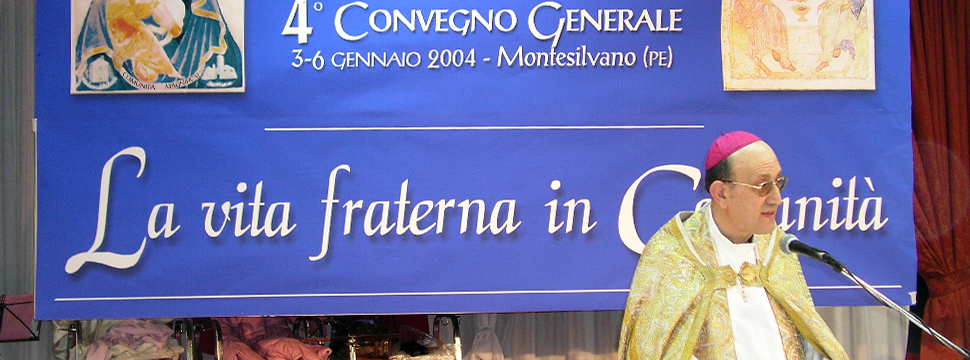
Monsignor Giuseppe Chiaretti, Archbishop of Perugia between 1996 and 2009, presides over the Covenant celebration during the Community’s General Convention in Montesilvano in January 2004.
2012
Work resumed on the renovation and finishing of the two apartments, the cloister, the Council Chamber and some of the facades of the complex; two allies, Luigi Fioroni and Stefano Lince, deepened their professional commitment there.
2014
On June 23, continuous Eucharistic adoration begins – Monday through Friday, day and night – at the small church of St. Manno.
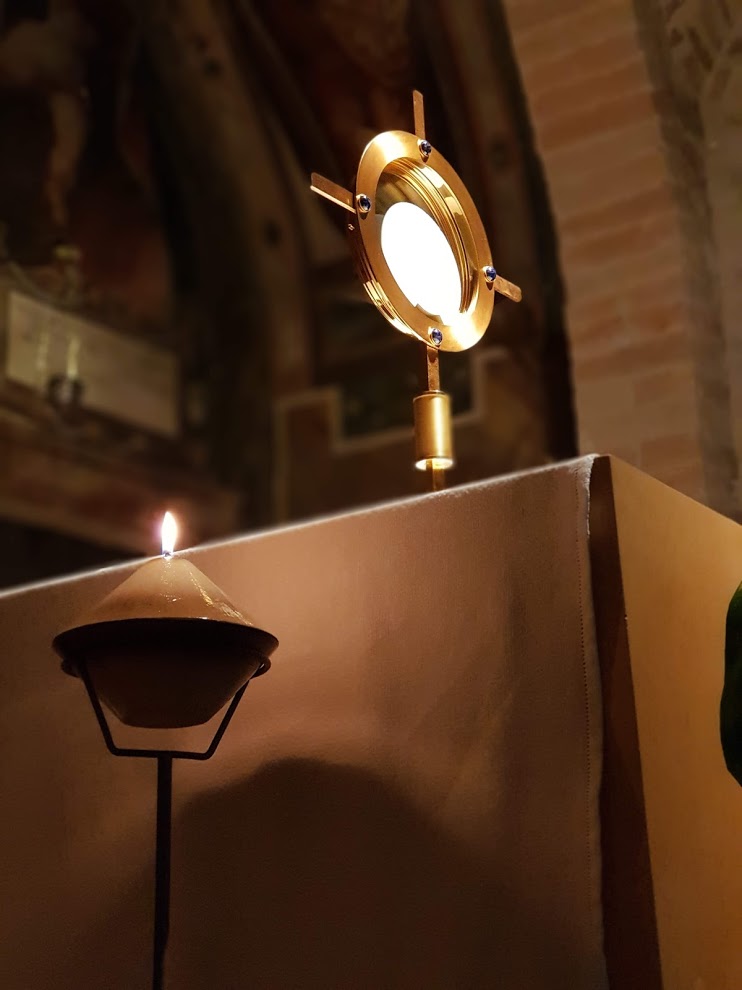
Ostia Magna, exposed for Eucharistic adoration on the small altar of the small church of St. Manno.
2019
Just as the decision is being made to set hand to the renovation of the northern part, the only one still unfixed of the whole complex, on March 18, a strange incident occurs: one of the load-bearing beams of that part breaks in a curious way: although it is not burdened by any weight at the point of the cleft-other than its own-the beam opens, like the mouth of a snake. This is probably due to a defect in the beam itself…. The fact is that, because of this incident, the newly deliberated work plan comes to a halt for securing the affected wing of the building and replacing the beam.
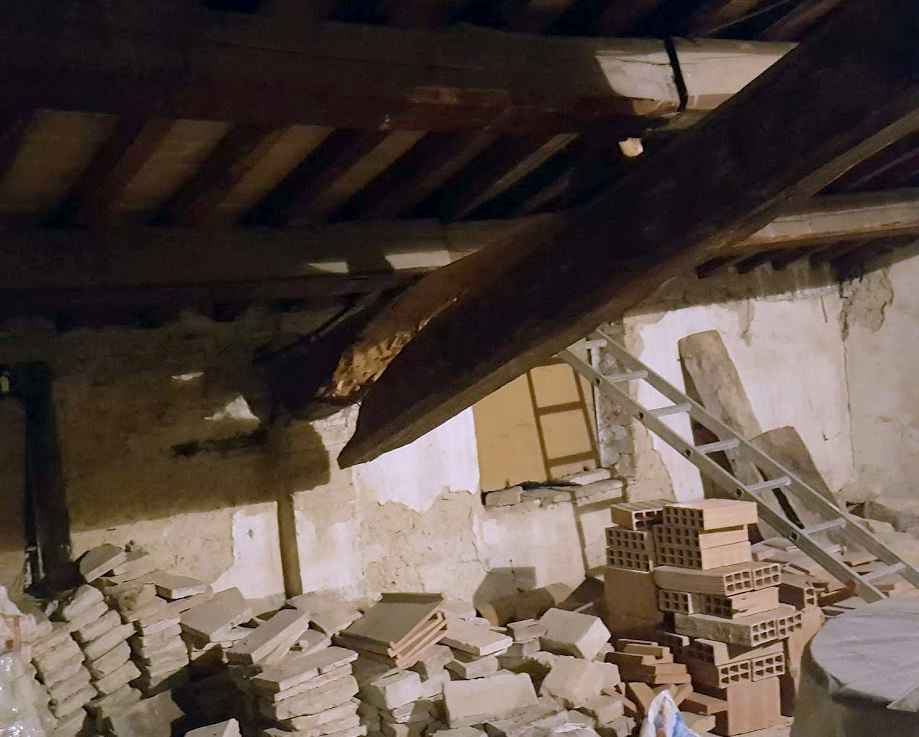
The beam of the still unreconstructed wing of St. Manno,
Broken on March 18, 2019 in a “curious” way.